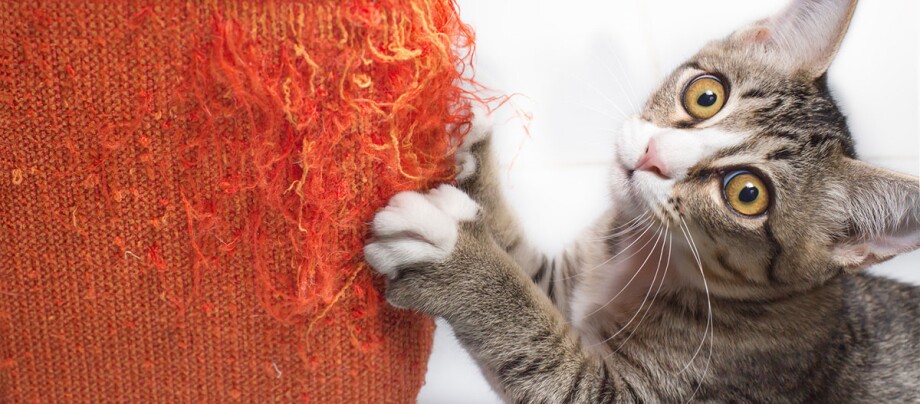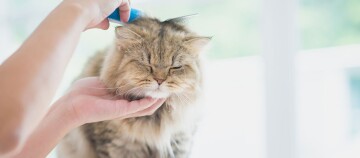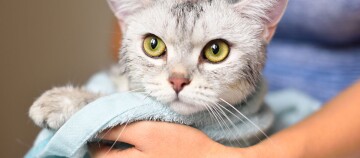Trimming Cat Claws Takes Practice - Make Your Cat Feel Relaxed
14.11.2022 - Reading time: 4 minutes

Without their claws, house cats would be severely impaired: Climbing the cat tree and furniture would be just as impossible as working on upholstered furniture and wallpaper. They are also used by cats to fish for objects, grab prey or toys and, last but not least, to attack or defend itself against other cats. As a cat owner, you have certainly become acquainted with your cat's "nails" more than once. Whether it's as part of a game or as a way of expressing themselves, you know exactly how sharp even a normal cat's claws can be. And you can imagine what happens when claws get too rampant.
Miracle of Anatomy Cat’s Claws
Claws are a successful model in the animal kingdom. Birds, lizards and reptiles, as well as most warm-blooded animals, have callused areas at the ends of their extremities. Anatomically, these are skin appendages and are made of horn, with keratin and bone components in the form of the last phalanx determining the structure of the hoof, claw, fingernail or claw. The cat’s claw has one very unique characteristic in the animal kingdom: only cats and some closely related creeping cats can retract or extend their claws at will. They do this with tendons that can retract or extend the claw in skin pockets in the paw by tensing or relaxing. If the claw is not needed at the time, ligaments passively retract it. When walking, the claws are retracted. Unlike many other animals, cats do not wear down claws by rubbing them on floor surfaces. This is why sharpening opportunities, in the form of cat accessories, for instance, are so important.
When should I trim my cat’s claws?
Cats who scratch will have well-groomed paws. Scratching on rough surfaces is part of their elementary activity repertoire. Outdoor cats sharpen their claws while climbing or on tree bark. Indoor cats use their scratching post to do this. Scratching wears away the outer horny walls of cats’ claws. However, some cats make too little use of sharpening opportunities or have claws that grow exceptionally fast and long, and in the long run, they hinder the animal. Cats with musculoskeletal conditions also often do not sharpen their claws because the movement causes them pain. In older cats, excessive claw growth can also be an indication of hyperthyroidism.
You should only trim a cat’s claws when they has grown so long that the cat can no longer move around without them being a hindrance. If, for example, they gets caught in the carpet pile while walking, there is a risk of injury, or if cats may injure themselves while grooming and scratching, it is time to take action. A cat’s claws that are too long can also break or split and subsequently grow back damaged. Don’t let that happen to your cat.
What tools will I need to trim my cat’s claws?
As for your own manicure or pedicure, you need the right tools for claw care. You can find them in specialty shop.
You need three things for a cat pedicure:
- Claw scissors work like normal scissors with two blades that have a special cut and fit next to each other when the handles are closed. For normal sized cat claws, a small pair of claw scissors is sufficient. Make sure they are well sharpened to cut cleanly.
- A claw clipper is a tweezer-like tool with two blades on the end that are guided towards each other. Unlike the nail clipper for humans, the tip of the claw fits into a recess. Do not use a manicure clipper for humans: The round cross-section of the claw requires a different cutting technique than a fingernail.
- You can buy styptic pencils at the pharmacy in the shaving supplies section. It is useful to have to hand in case something goes wrong during claw trimming and there is slight bleeding.
By the way: If you are not comfortable trimming claws or do not feel able to do it yourself, you can always ask your vet to do it.
How short can I trim my cat’s claws?
Trimming cat claws takes practice. Most cats don’t like it when you touch their paws. You should therefore get your cat used to having their paws touched in a playful way early on, preferably when it is still a kitten. Use a bribe: A treat at the right time associates touching its paws with positive notions for the cat. Wait until the cat is relaxed before trimming its claws. After eating or when they are sleepy is a good time. Do not force the animal into having its claws trimmed or even hold it down by force. This may cause a defensive reaction or frighten the animal. To reach the claws, apply gentle pressure with your fingers to the ball and top of the paw. This should push the animal’s claws out a little. In cats with light coloured claws, you can clearly distinguish the horny part and the medulla, which stands out towards the paw. The medulla is the “living” part of the claw and contains the nerves and blood vessels.
A tip:Shine a torch on the claw. That makes it much easier to see the blood vessels. Then trim sufficient far away from the claw medulla. If your cat has such dark claws that it is difficult to see the medulla, use the lightest claw as reference: The medulla is equally distributed in all the claws.



